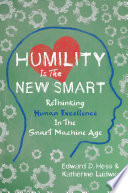

In today's fast-paced and complex world, humility is emerging as a critical leadership quality. Unlike traditional views that equate leadership with authority and confidence, this book argues that effective leaders must possess the ability to listen, learn, and adapt. Humility allows leaders to acknowledge their limitations and the contributions of others, fostering a collaborative environment. This idea emphasizes that leaders who exhibit humility can better navigate challenges, build trust, and inspire their teams, ultimately leading to better organizational outcomes.
Continue readingThe book highlights the significance of adopting a growth mindset, which is the belief that abilities and intelligence can be developed through dedication and hard work. This mindset is crucial in an era where change is constant, and innovation is key to survival. By embracing a growth mindset, individuals and organizations can cultivate resilience, creativity, and a willingness to learn from failures. The authors argue that humility is a precursor to a growth mindset, as it encourages individuals to seek feedback, learn from others, and continuously improve.
Continue readingHumility fosters a culture of collaboration rather than competition. The book posits that in an interconnected world, the ability to work together is more valuable than individual achievements. When individuals approach their work with humility, they are more likely to share knowledge, support one another, and leverage the strengths of diverse teams. This collaborative spirit not only enhances problem-solving but also drives innovation, leading to more sustainable success for organizations.
Continue readingEmotional intelligence (EQ) is closely linked to humility, as it involves understanding and managing one's emotions and the emotions of others. The authors stress that leaders with high EQ can better empathize with their team members, fostering a supportive and inclusive work environment. Humility allows leaders to connect on a deeper level, recognizing the value of their team's feelings and perspectives. This emotional awareness is crucial for conflict resolution, team cohesion, and overall workplace morale.
Continue readingThe book discusses how humility enables individuals to view setbacks and failures as opportunities for growth. Instead of being defensive or placing blame, humble individuals take responsibility and reflect on their experiences. This perspective not only promotes personal development but also encourages a culture where teams can learn collectively from mistakes. By embracing adversity with humility, organizations can foster resilience and a proactive approach to challenges.
Continue readingAs technology continues to evolve, the nature of work is changing rapidly. The authors argue that humility will be a defining trait for successful professionals in the future. With automation and AI taking over routine tasks, the human skills of empathy, collaboration, and critical thinking will become increasingly valuable. Humility will enable individuals to adapt to new roles, learn from others, and contribute meaningfully in a collaborative work environment, thus ensuring their relevance in the workforce.
Continue readingThe final key idea focuses on the importance of cultivating a culture of humility within organizations. This involves creating an environment where feedback is encouraged, mistakes are viewed as learning opportunities, and everyone feels valued. The authors provide practical strategies for leaders to promote humility, such as modeling humble behavior, recognizing team contributions, and fostering open communication. By embedding humility into the organizational culture, companies can enhance employee engagement, satisfaction, and performance.
Continue reading